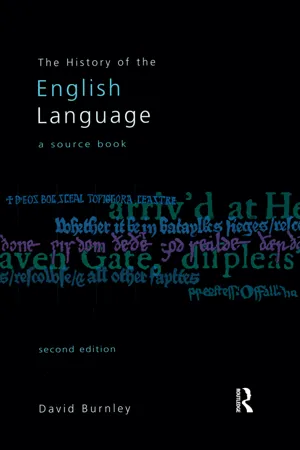
- 440 pages
- English
- ePUB (mobile friendly)
- Available on iOS & Android
About this book
This second edition of The History of the English Language- A Sourcebook provides a comprehensive and accessible guide to the origins and development of the English language. First published in 1992, the book contains over fifty illustrative passages, drawn from the oldest English to the twentieth century. The passages are contextualised by individual introductions and grouped into the traditional periods of Old English, Early Middle English, Later Middle English, Early Modern English and Modern English. These periods are connected by brief essays explaining the major linguistic developments associated with each period, to produce a continuous outline history.
For this new edition Professor Burnley has expanded the outline of linguistic features at each of the main chronological divisions and included more selections and illustrations. A new section has also been included to illustrate the language of advertising from the 18th century to the present. The book will be of general interest to all those interested in the origins and development of the English language, and in particular to students and teachers of the history of the English language at A-level and university.
Frequently asked questions
- Essential is ideal for learners and professionals who enjoy exploring a wide range of subjects. Access the Essential Library with 800,000+ trusted titles and best-sellers across business, personal growth, and the humanities. Includes unlimited reading time and Standard Read Aloud voice.
- Complete: Perfect for advanced learners and researchers needing full, unrestricted access. Unlock 1.4M+ books across hundreds of subjects, including academic and specialized titles. The Complete Plan also includes advanced features like Premium Read Aloud and Research Assistant.
Please note we cannot support devices running on iOS 13 and Android 7 or earlier. Learn more about using the app.
Information
Table of contents
- Cover Page
- Half Title page
- Title Page
- Copyright Page
- Dedication
- Contents
- List of plates
- Acknowledgements
- Preface to the First Edition
- Preface to the Second Edition
- Abbreviations
- Symbols
- Chronology
- Old English (700–1100)
- Early Middle English (1100–1300)
- Later Middle English (1300–1500)
- Early Modern English (1500–1800)
- Modern English (1800–1920)
- Appendix
- References and Background Reading
- Index